Putting practice is essential and is the easiest way for most people to lower their score. A two hour practice session is what I consider reasonable for average players. Let’s take a look at my setup.
Normally, I will roll 3 balls in each direction multiple times on the drills below.
One exception would be if I’m having a bad day. In that case, I might use the dozen balls that I bring.
Another exception is on my short straight line putts where I try to make 10 in a row to end the day for each distance.
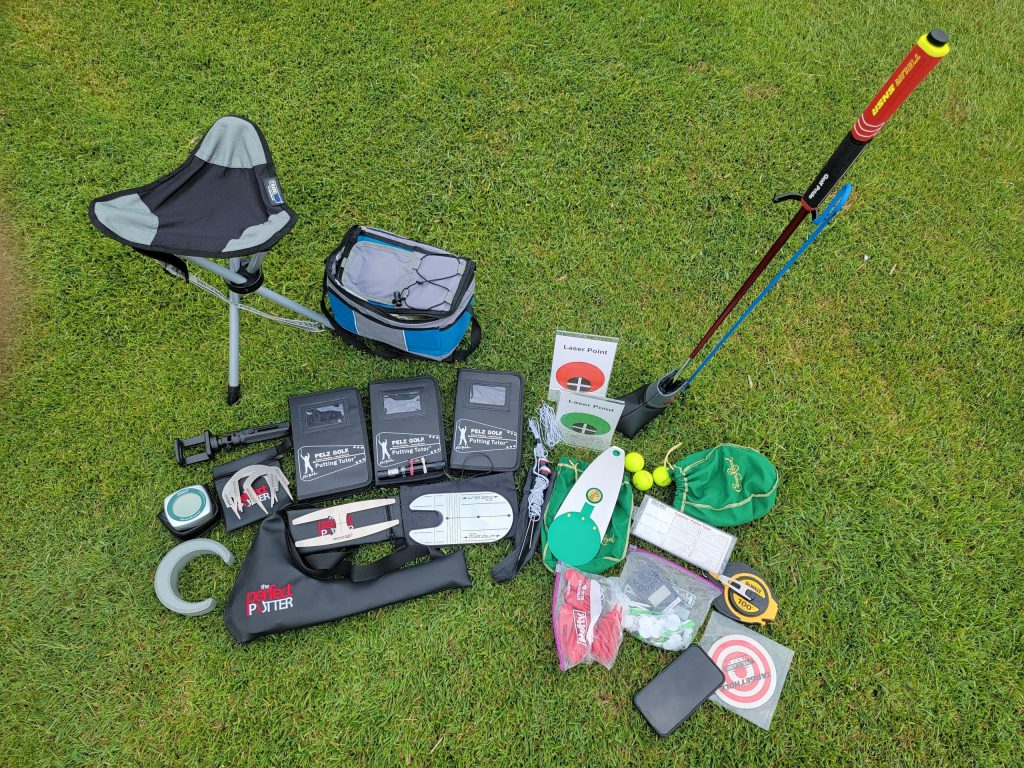
Equipment
This is the stuff I regularly take to the practice green for a two hour practice.
Note: Because I was taking photos, I was not able to use every item I brought in the two hours I was there. What I didn’t get to was the 3 Pelz putting tutors and The Perfect Putter H alignment aid. I set them up in a North, South, East and West pattern around the hole from 3 feet to 6 feet. I also did not get to the SKLZ putting cup accuracy trainer.
List of items:
- Camp stool
- Cooler bag to carry everything in. (Most of it)
- Tripod and Phone holder
- 3 Pelz putting tutors
- Two homemade long range targets (Upright)
- Putter
- Putter stand
- Exelys Breakmaster (Slope guage)
- The Perfect Putter metal gates
- The Perfect Putter H alignment aid
- SKLZ putting cup accuracy trainer
- The Perfect Putter Tour Model (stimp meter / alignment tool)
- PuttOUT compact putting mirror
- Pelz elevated string line
- Hand held green dot laser (to line up mirror and gates with hole)
- PuttOUT premium pressure putting trainer
- A dozen golf balls (I normally just use 3, but have used all 12)
- Pelz putter impact tape
- 20 plastic divot tools for putting stations
- 20 quarter size ball markers for putting circles
- Metronome (battery operated) – optional
- 100 foot tape measure
- 3 target holes
- iPhone with golf apps (Green Reading / Metronome apps)
Putting Two Hour Practice – Stimp
When I arrive at a golf course or practice putting green, I always check the roll out or stimp based on a fixed distance that I know the backstroke length for.
Most of the time I pick out a spot on the green that is about 30 feet wide and try to putt from fringe to fringe.
This would be a dozen putts. 3 balls each way twice equals 12 putts.
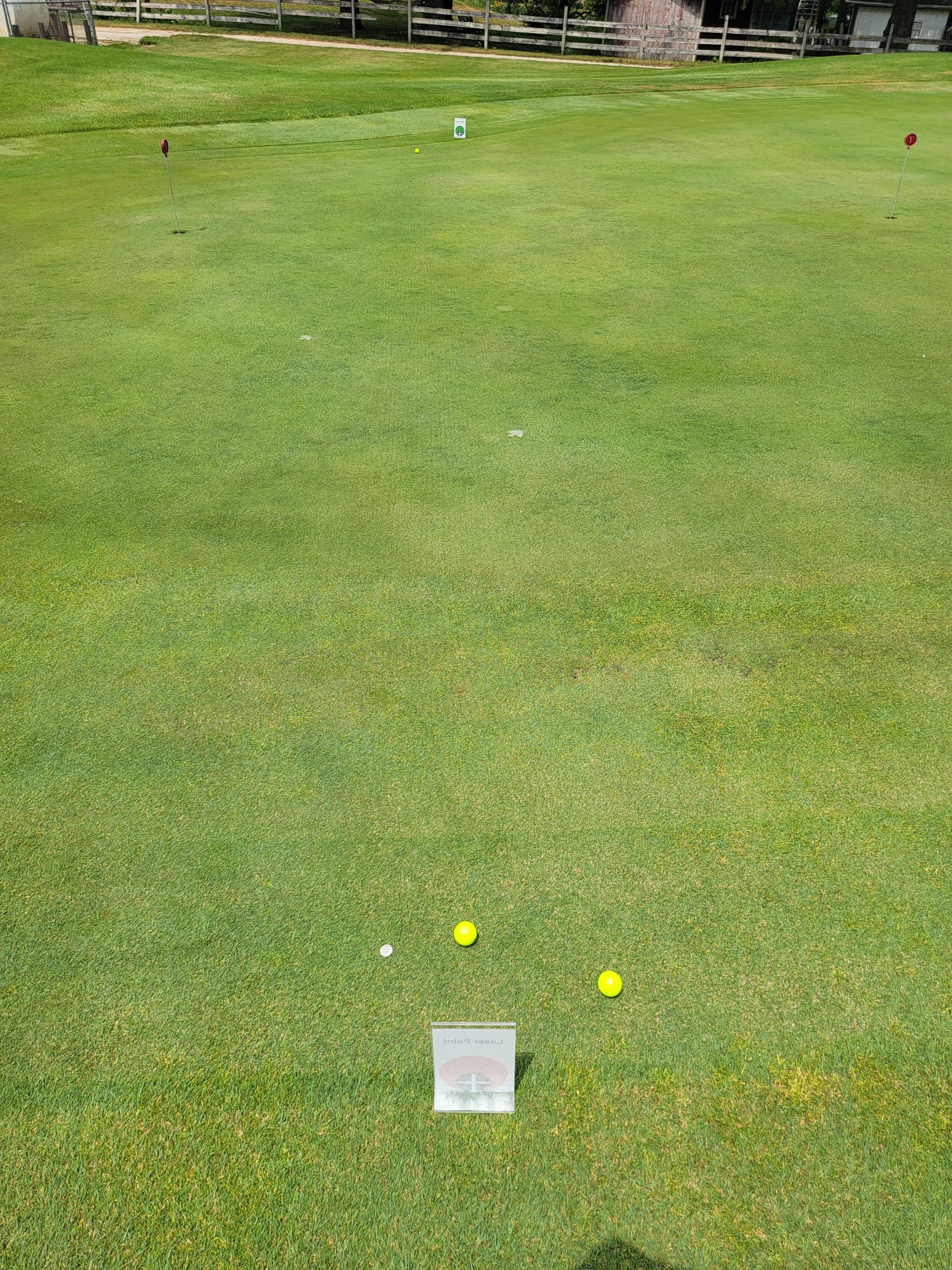
Next, I check the actual stimp with The Perfect Putter Tour.
First, you mark the front of the device with a coin or ball marker.
Then roll 3 balls down the true roller from the “0” mark on the side.
Measure the average distance 3 balls roll. Mark that average spot with a ball marker and repeat the process in the opposite direction.
Use the average of the two lengths and that is the stimp.
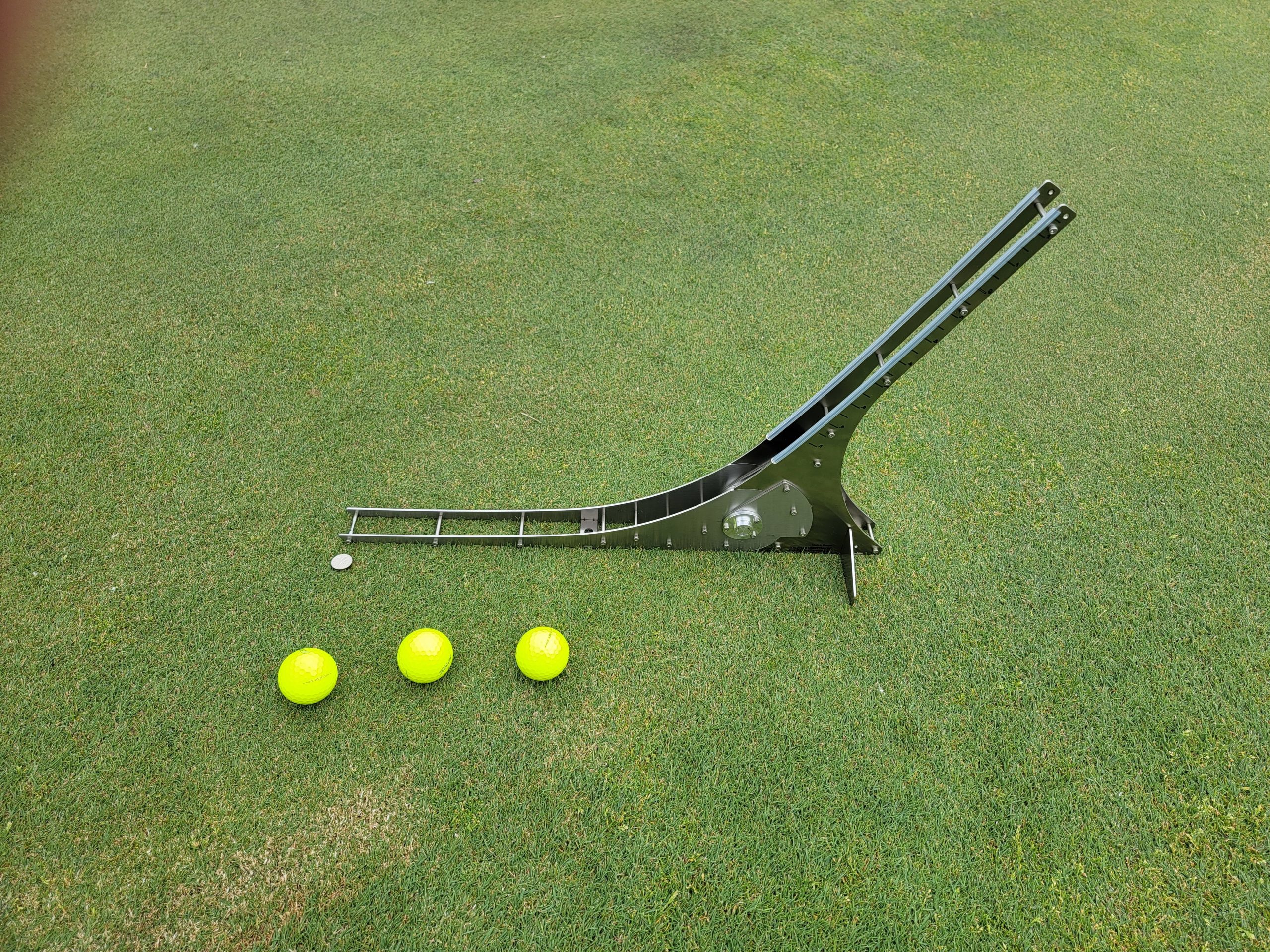
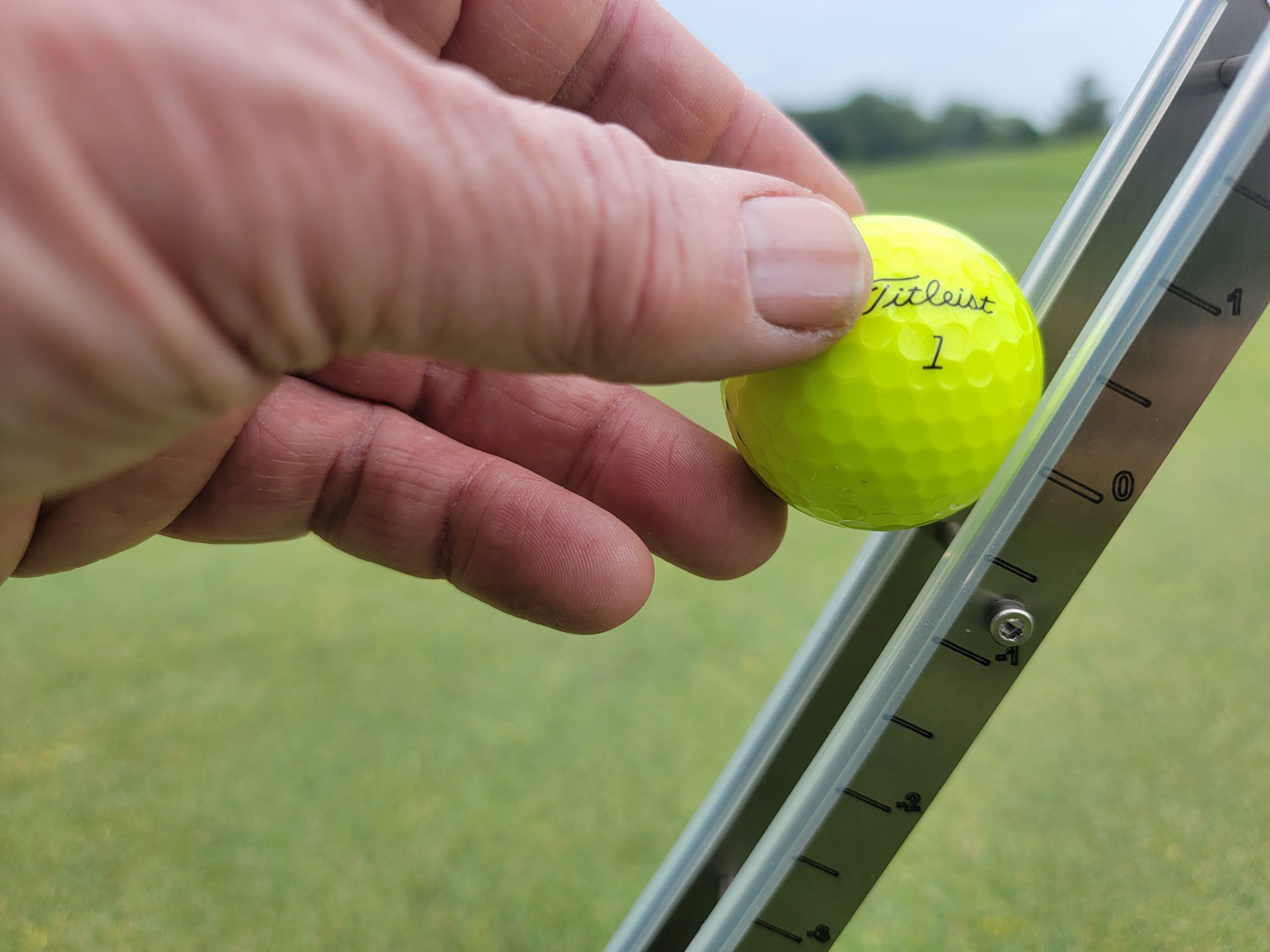
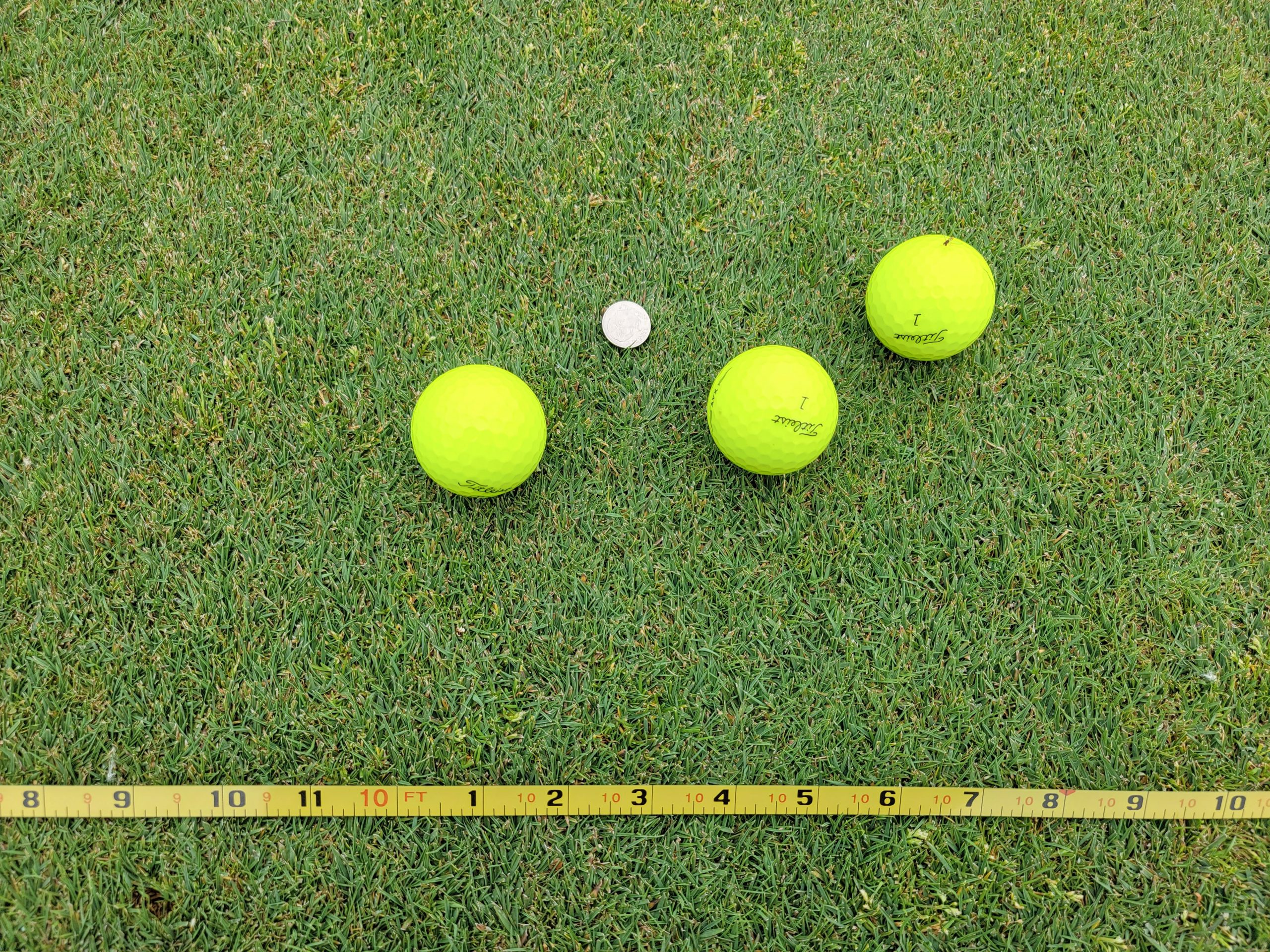
Example: There aren’t any real flat spots on our practice greens. I rolled the 3 balls slightly uphill to 9 plus feet.
Repeating the procedure slightly downhill, the measurement was 10.5 feet.
I called it a strong 9 stimp to 10 stimp.
Putting Two Hour Practice – Lag Drills
I like to do at least two sets of lag drills. Most of the the time, I start out with 30 to 40 footers.
This would be about 30 putts or 15 in each direction.
Select an area on the green that has break both uphill and downhill. I’m most comfortable putting lag putts at 30 feet to start.
Those are uphill with a 2 foot left to right break and downhill with a 2 foot right to left break.
I use used vertical hole markers I made from plastic menu holders. I place them behind the hole.
Walk this distance off and / or measure it with a tape measure. I do both just to check my distances (walking) for real time play on the course.
Note: The vertical hole markers serve two purposes. One is the max distance I want to go by if I miss. The other is a target past the hole so I don’t leave the putt short.
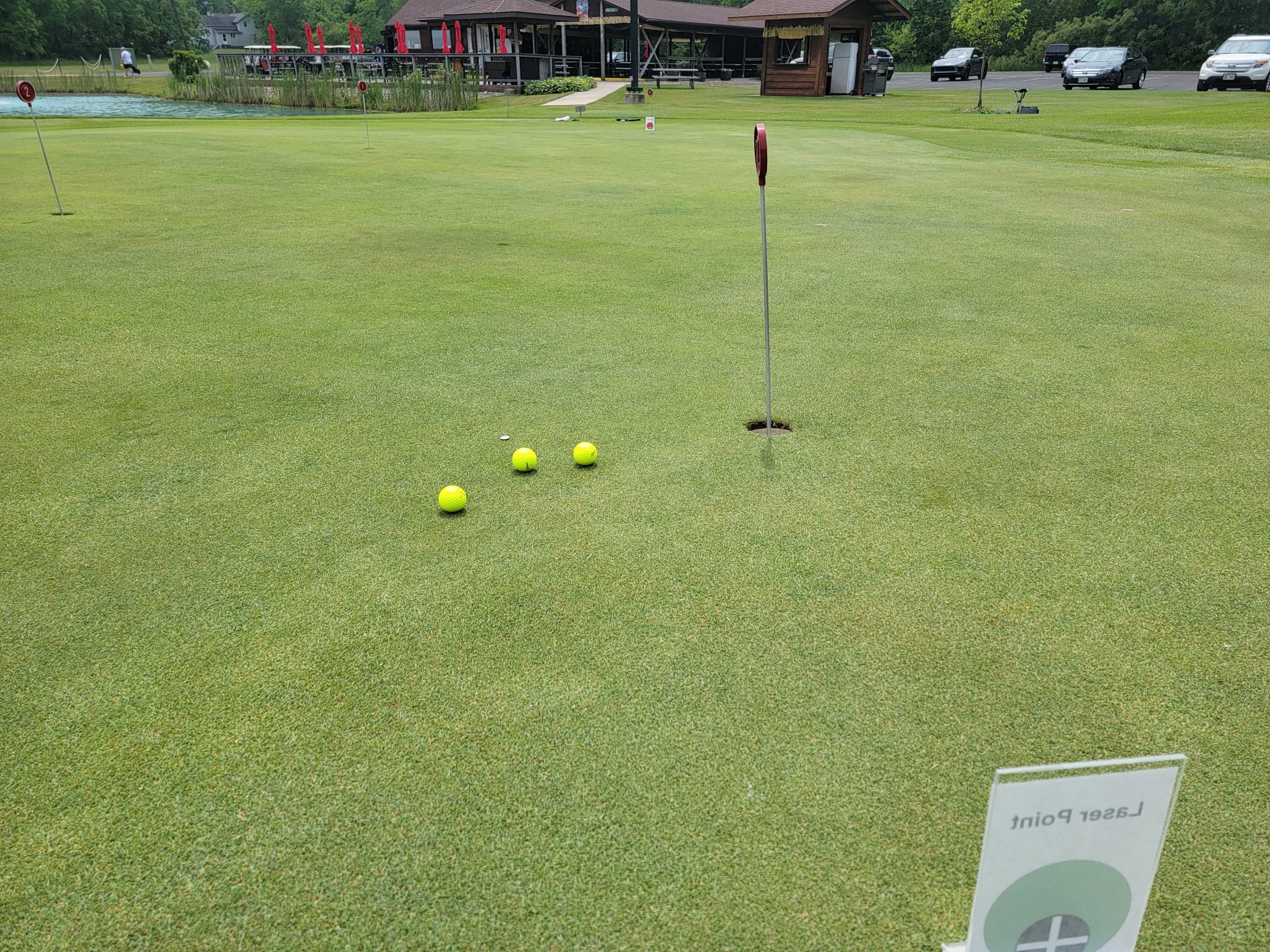
Using vertical hole markers (plastic menu holders), I set up a 60 footers. Try to find a relatively flat area, but with some break. I putt from both directions.
This would be about 30 putts or 15 in each direction.
I put the hole markers about 4 feet past the hole.
Many people try to lag within 10 percent of the total distance. In other words, if it’s a 60 footer putts should be within 6 feet.
I like to try to get it closer than that or within 3 to 4 feet. The whole idea behind great lag putting is to not 3 putt.
Putting Two Hour Practice – Straight Line Drills
Hole locations on practice greens aren’t always on flat areas. I bring Eyeline target holes with me and place them as needed on flatter areas for putts straight up the fall line of the green.
There are a couple similar drills that I practice.
One is using a Pelz elevated string line and the other is using a metronome.
The elevated string line drill is basically straight putts from 10 feet under the elevated string line. That drill is for face angle at impact and speed.
This would be about 20 putts.
The metronome drill is also 10 feet, but with no string line and includes audible tempo at 76 beats a minute.
My battery operated metronome sits on the green, while my phone / metronome app sits in a tripod with a phone holder.
This would be about 20 putts.
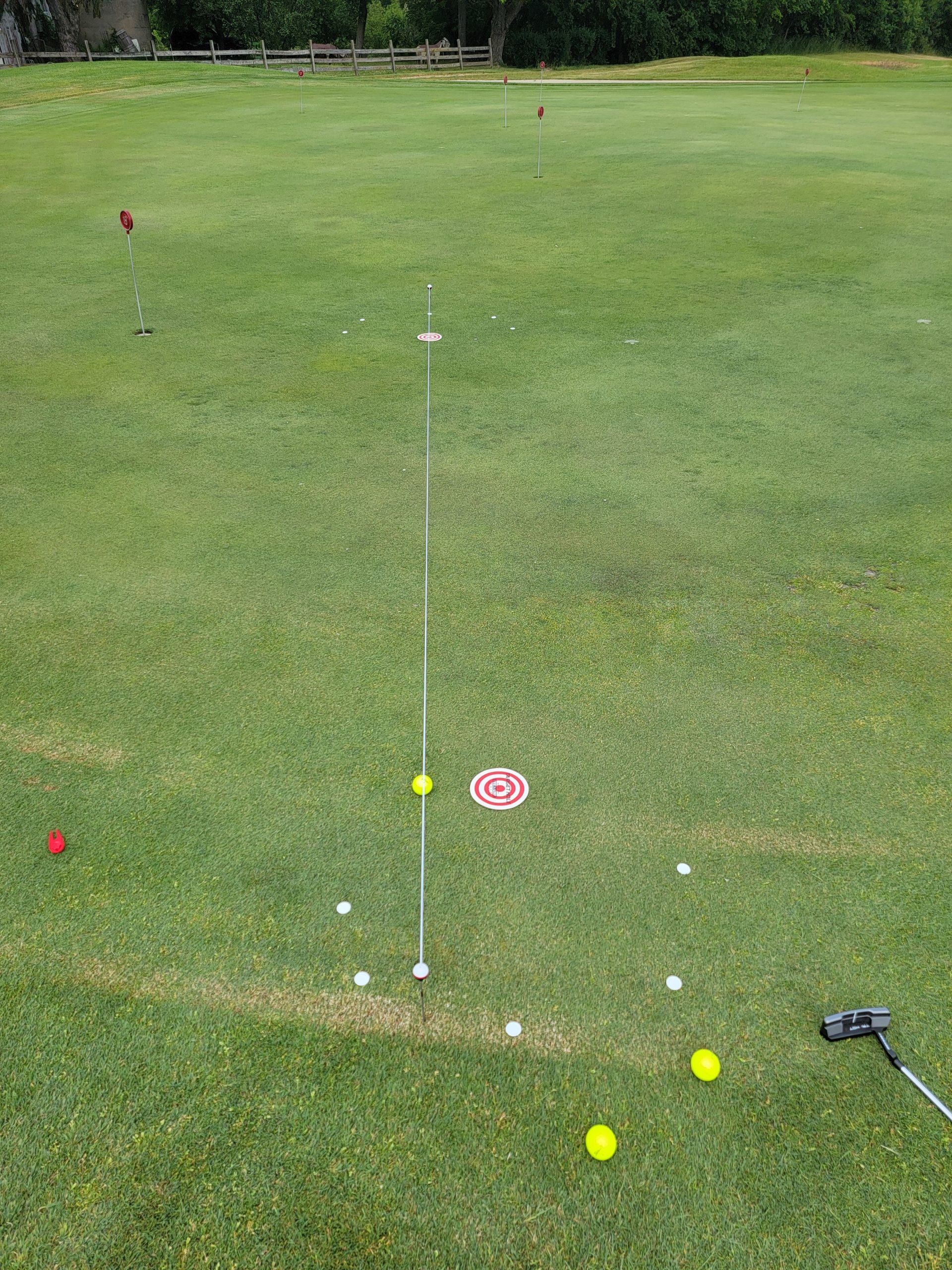
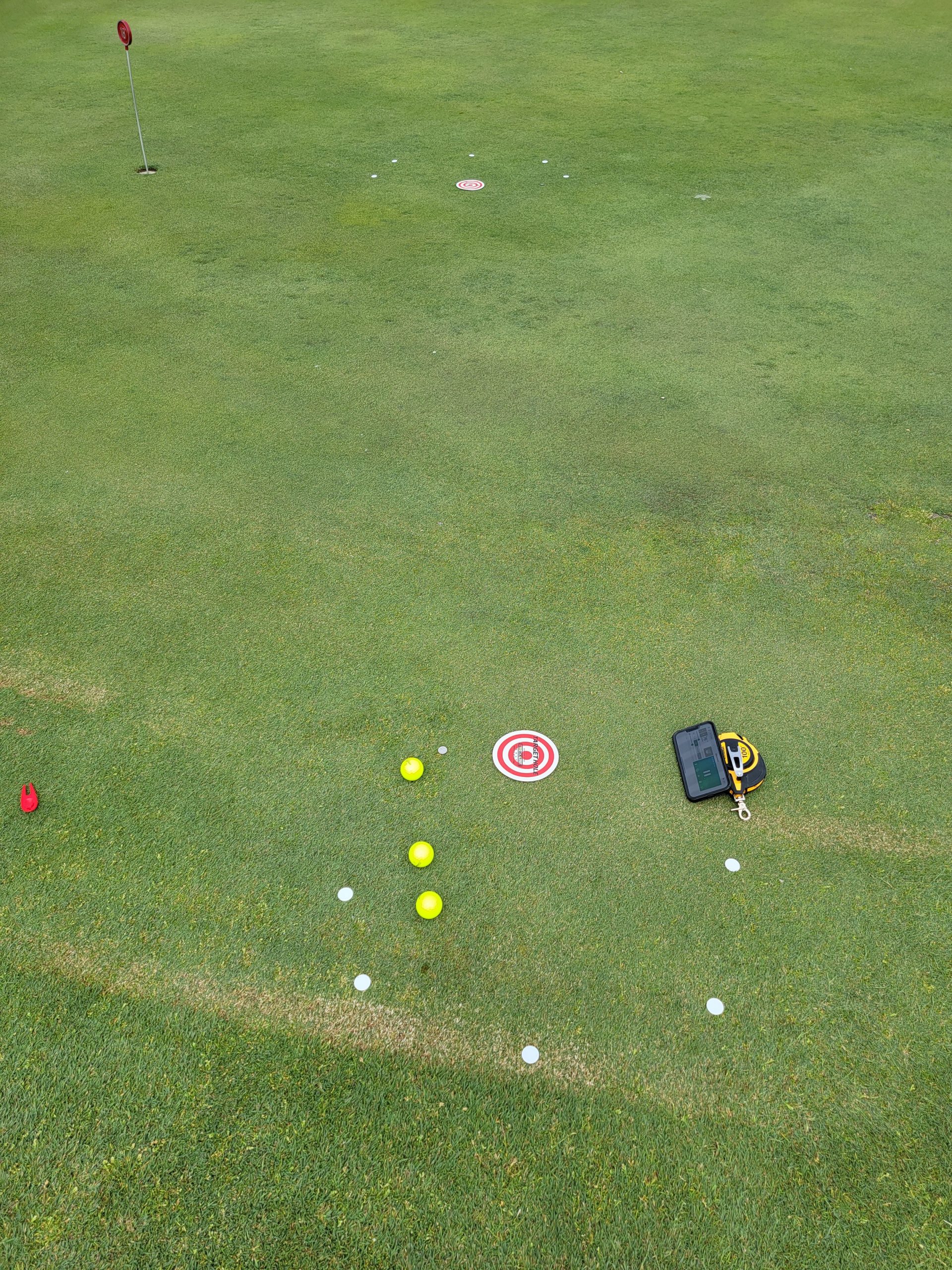
Putting Two Hour Practice – Green Reading
Until recently, I practiced my green reading ability using a golf tee as my aim point or an elevated aim line from the ball to the aim point.
The test was and still is making the putt.
I purchased a life membership for Slopegraide over the winter. It works on my iPhone and has an augmented reality green reading feature.
It works really well outside on the practice green. You locate your ball and the hole and it tells you where to putt, etc. The lidar on your iPhone maps the green for you.
I roll about 10 putts doing using the Slopegraide green reading method.
Another, option I like to use for green reading is to guess where the fall line is and measure it.
You can do this several ways.
One would be to use the Exelys Breakmaster to measure slope direction.
Another, would be to use the Breakmaster phone app.
A simple way to find the fall line is to take a plastic plastic plate and roll a golf ball around on it like a roulette wheel.
Where the ball stops is the fall line.
I do this by time. I like to spend 10 to 15 minutes reading breaks, then taking putts to verify my read.
Our article on Digital Green Reading
Putting Two Hour Practice – Short Putts
I set up 3 and 6 footers using my putting mirror, two golf tees, a putting gate and putting ramp.
To line up everything in the straight line I use a handheld pen style green dot laser. It just easier than “eye balling” the line and speeds things up.
I have a couple of fancier lasers, but the hand held is just quicker.
For example on the three foot putt, I place the putting ramp down first, then the mirror 3 feet from that on a straight line.
Then, I shine the green dot laser down the target line in the middle of the mirror and then place a putting gate about a foot in front of the mirror centered over the laser line.
Lining these three items up with a laser is a lot quicker.
In addition, I place a tee on either side of the mirror for a putter gate.
This is usually the last drill I do for the day. The object is to make 3 footers10 in a row with out hitting the ball gate or putter gate. From 6 feet, I like to make 5 out of 10 or better.
That ends the practice.
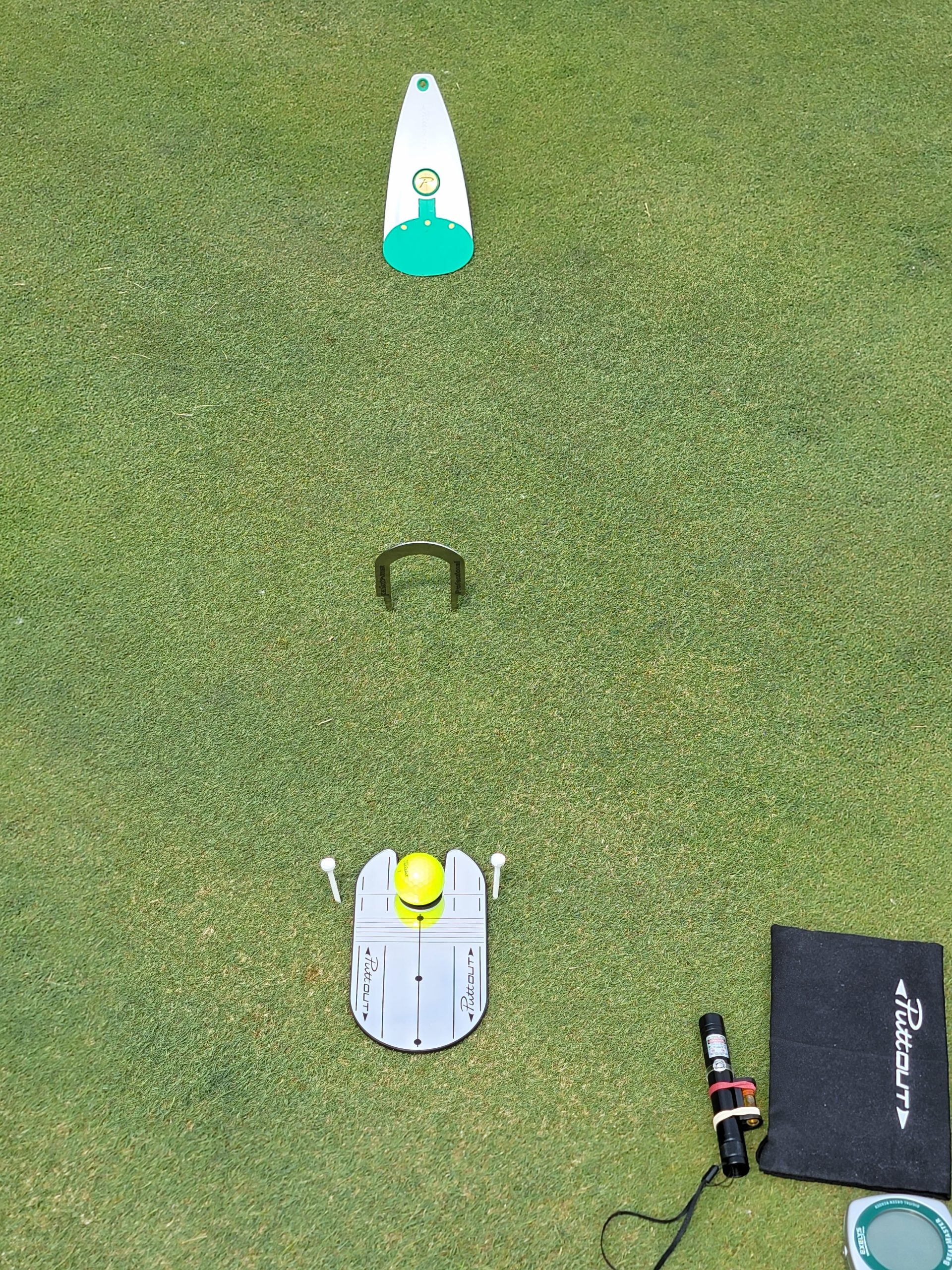
Additional Drills
As I mentioned above, I was unable to complete two drills as a result of taking photos.
I usually set up 3 Pelz Putting Tutors and The Perfect Putter H alignment aid in a star pattern or North, South, East and West setup.
The object being taking 3 putts at each location. This drill is intended to be two straight putts and two breaking putts.
North and South would be straight uphill and downhill while East and West would be right to left and left to right breaking putts.
The other drill involves the SKLZ putting cup accuracy trainer. I use this for practicing breaking putts from 3 and 6 feet. I makes the hole look smaller and forces you to gauge the proper entry point to the hole.
This would be about a dozen putts.
General Guidelines
Note: It takes time to set up the drills and I do sit down in the shade from time to time. Two hours isn’t really that much time.
If I’m obviously having trouble with centeredness of contact on the putter face, I will take several putts with Pelz Teacher Tape / Impact Tape to see where I’m striking the ball on the putter face.
I know that the distance between my feet is two putter widths. I play the ball off the inside of my left foot.
So for a 5 footer, the backstroke length is to the middle of my stance.
A 10 foot backstroke is to the inside of my right foot.
Outside my right foot is a 15 footer.
Past that, approximately every two inches is another 5 feet in putt length.
One thing you hear all the time in putting is to keep the lower body stable, arms stable, grip stable and rock your shoulders.
That works for me up to about 30 feet.
After that, I feel like Frankenstein standing there.
I have to start to rotate to a modest degree to putt 60 footers for example or it seems like my body gets in the way.
